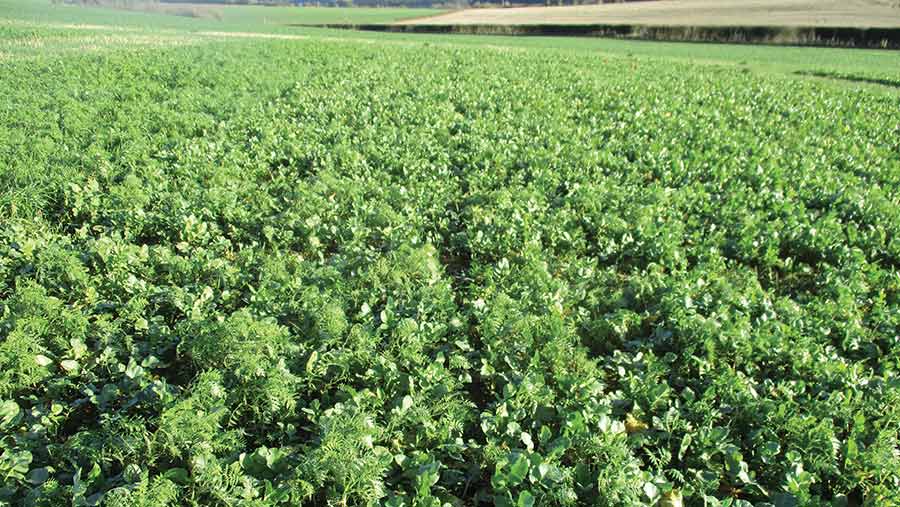Cover crop study shows yield benefits of destruction methods
 © Tim Scrivener
© Tim Scrivener Research funded by water companies has revealed significant differences between cover crop destruction methods for nitrogen availability in the following crop and weed control.
A further project has highlighted the value of a clover companion crop grown beneath winter wheat in a droughty spring.
Farmers Weekly looks at the findings presented at the recent Association of Independent Crop Consultants conference in Northamptonshire.
See also: How treated urea is helping farming company to improve NUE
Trial 1: Cover crop destruction method
Cover crops are valuable for mopping up nitrogen over the winter period, but little is known about how nutrients are released for the following crop.
Adas soil scientist Dr Anne Bhogal is looking at the impact of destruction method in trials being carried out for Portsmouth Water and Affinity Water.
She says there is increasing interest in alternative methods to glyphosate, like crimper rolling on a frost and flailing.
However, there is little data on how these non-chemical methods affect nitrogen release and seed-bed quality.
So she set out to investigate the legacy effects of cover crops on nitrate leaching and crop performance.
Two mixes were used, one with and one without brassicas, alongside two different destruction techniques at two different sites. The brassica used was a clubroot-resistant oil radish.
Treatments |
||
|
Cover crop |
Destruction method |
|
|
West Sussex |
Hertfordshire |
|
|
No cover, weedy stubble |
Chop and incorporate v glyphosate |
Roll on a frost v glyphosate |
|
Mix 1: Phacelia and oil radish |
||
|
Mix 2: Japanese oats, buckwheat and phacelia |
||
|
Spring crop |
Barley |
Oats |
| Source: Adas | ||
Data confirmed that cover crops reduced nitrate leaching by up to 90%. “The brassica was very effective at mopping up nitrate, although the other mix had caught up by the end of the year,” Anne said.
She highlighted that up to 25kg/ha of nitrate was lost from the stubble in Sussex, showing the leaching risk of having no cover.
Testing showed over 70kg/ha of nitrogen was captured in the cover crop. When combined with soil reserves, there was up to 100kg/ha of nitrogen potentially available for the spring crop.
She then looked at how the destruction method used affects this being released to the next crop.
Cultivating and drilling the spring crop promoted breakdown of the cover crop material.
Consequently, she saw more a more rapid N release to the subsequent spring crop with glyphosate compared with mechanical destruction.
However, there were problems later in the season, with the mechanical chop and incorporate approach.
By May, they started to see weeds in West Sussex, especially oil radish, as it started to regrow. Volunteers also started to appear.
Therefore, they had to go with more herbicide. This wasn’t a problem with rolling on frost at the other site.
On the West Sussex site, she saw a 1t/ha benefit of the brassica cover crop. However, there was a 0.7-1t/ha yield decrease with mechanical destruction and mix 1, where oil raddish was present.
She believes this is down to the oil radish regrowth and absence of the early N release.
The Hertfordshire site saw a similar pattern, but yields were more variable due to blackgrass patches. There was an additional 10kg/ha N uptake, with chemical destruction and a yield reduction with rolling on frost.
On top of this, there was a lower specific weight in the following oat crop with mechanical destruction. Early N is key to specific weight and there was a less rapid release with the mechanical approach.
Finally, looking at soil mineral nitrogen, the poorer cash crop performance resulted in higher residual N, which was at greater risk of leaching.
This year, she is not just looking at destruction method, but looking at the timing of cover crop destruction, and the impact on the following crop.
Trial 2: Clover in wheat
Establishing a clover understory could prove useful in supplying nitrogen to crops in a dry spring, when fertiliser uptake is limited.
That’s one of the findings from a trial carried out on a very high yielding farm, funded by Portsmouth Water.
Independent agronomist Jonathan James looking at whether a clover living mulch could help farmers cut overall fertiliser use.
He had four treatments:
- Treatment 1: untreated
- Treatment 2: Field standard + clover
- Treatment 3: Clover + 10% N reduction
- Treatment 4: Clover + 20% N reduction

© Adas
He reported that the clover was established after vining peas in late July. Wheat was then drilled into it using a Vaderstad Rapid, and he saw good wheat establishment and nodulation on the clover roots.
By April, the clover got quite competitive, so he needed to knock it back with a herbicide. It ended up being more of a companion crop trial, he says.
There was no yield benefit, but treatment 3 saw a slight lift in grain protein content. Nitrogen use efficiency was also highest in treatment 3, at 89%.
One problem was that he did see pea aphids on the clover, so the rotation needs to be long enough to avoid problems in the vining peas. Having clover also reduces the pre-emergence herbicide options.
Wheat variety choice is also important. He picked Extase for its rapid autumn growth. Those that are slower to get away like Dawsum may not be suitable.
In conclusion, the clover did supply free nitrogen, and it did increase the nitrogen use efficiency.
He sees it having a potential role in a droughty spring. In a dry April/May, its uncertain if the fertiliser will be taken up. Killing the clover releases nitrogen, and that supply could help in periods of impaired fertiliser uptake.
Portsmouth Water’s strategy to reduce nitrate levels in groundwater
Portsmouth Water is funding farmers to grow cover crops, offering capital grants for precision farming, as well as funding unique research as part of its strategy to reduce nitrates in groundwater.
The company’s catchment and environment manager Simon Deacon explains that the area (in the South Downs) is mostly covered with chalk, and is very reliant on groundwater having no surface reservoirs.
85% of its water comes from boreholes and the rest is from the River Itchen, which is itself groundwater fed.
Of the 19 groundwater abstractions, 11 are affected by high nitrates. And the long-term trend in the catchment is that its getting worse.
He says the biggest issue is the seasonal spikes, which are increasingly exceeding the 50mg/litre limit.
“It is very expensive to treat water, so we blend it.” But he says it is now getting to the point where they will have to put in treatment plants.
Agriculture is the main source, and the firm is working with farmers to reduce the spikes.
Funding schemes
They are running two schemes (see box), one of which is paying farmers to adopt practices like cover cropping and soil mineral nitrogen (SMN) testing to estimate soil reserves.
If a farmer wants to do SMN testing, the company will fund it, and provide specialist advice.
On the capital grant side, Simon points to one farm that secured a £8,532 grant for a dribble bar and flow meter on the slurry spreader to allow more precise applications.
The farmer previously used a splash plate, but there was a greater risk of over application and N leaching into ground water.
Looking to the future, Portsmouth Water is also funding pilot trials like the Adas cover crop destruction trial (see panel) and leaf protein testing (see Trial 1).
This year, work is looking at urea and urease inhibitors, as he says there is some concern that their use could mean more N is leachable into groundwater.
Portsmouth Water schemes
- Engaging with farrmers and landowners to reduce nitrate leaching and have 114 priority farms.
- Running two schemes with incentives:
- Payments to farmers to deliver measures to reduce nutrient leaching like cover cropping, undersowing crops, soil N testing and N mapping advice.
- Capital grant scheme – grant payments for improvements to reduce run-off from farm yards and equipment to optimise fertiliser and manure/slurry applications.
Simon Deacon, Dr Anne Bhogal and Jonathan Jones were all speaking at the recent Association of Independent Crop Consultants conference near Towcester, Northants.

